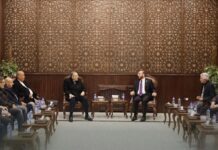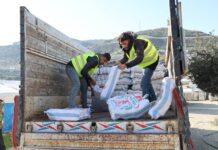
Military movements and attacks by the criminal Bashar al-Assad’s forces have escalated across northern Syria, raising alarms of a potential large-scale offensive that could displace thousands of civilians. Assad’s forces, backed by allied militias and Russian support, have been massing on the front lines in Aleppo and Idlib, signaling possible intentions to launch an assault on the liberated territories of northern Syria.
The latest surge in hostilities occurred as Saleh Al-Abdullah, a prominent military commander, took control of the front lines in the western Aleppo countryside. The Assad regime’s elite 25th Division, renowned for its offensive capabilities, has taken the lead in reinforcing and supporting the axis. Villages along the western Aleppo countryside – including Al-Eis, Tal Hadiya, Bans, and Hawir Al-Eis – have seen an influx of regime forces and allied militias, heightening concerns of an imminent attack.
On Tuesday night, a convoy of Iranian-backed militias departed Al-Nayrab military airport with machine gun-mounted pickup trucks and tanks, moving toward the western Aleppo countryside. Local sources report that many of these forces show signs of deteriorating morale, yet reinforcements continue to arrive, further entrenching the Assad regime’s position.
The escalation has been marked by relentless artillery shelling. On Friday, October 11, regime forces targeted the town of Afes, east of Idlib, with heavy artillery, following a similar barrage on Darat Izzah in the western Aleppo countryside. These attacks, indiscriminately hitting civilian areas, have caused widespread displacement and stoked fears of further violence as Assad’s forces push towards revolutionary-controlled territories.
The massing of regime forces has coincided with veiled threats from Assad’s Russian allies, who have raised the possibility of chemical attacks. These statements have fueled anxiety in liberated areas of northern Syria, as chemical attacks have been a hallmark of the regime’s brutal tactics in previous campaigns. Observers fear that these threats are intended to justify the regime’s potential assault under the guise of combating “terrorism,” a strategy used in past offensives.
While the buildup of forces and artillery attacks suggest a looming offensive, there are conflicting reports about the actual scale of the military movements. According to local military analysts, some of the recent convoys spotted in northern Syria are merely returning from operations in central Syria, rather than new reinforcements aimed at launching a fresh assault.
“Most of these forces had completed their mission in the Homs desert and are now redeploying to their original posts,” said Abu Amin, a field monitor specializing in northern Syria. “The Assad regime exaggerated the movement by publicizing it on loyalist media, but we have not seen evidence of new specialized weaponry or signs that suggest an imminent major military operation.”
Nevertheless, the continuous arrival of convoys, including tanks, along the Aleppo and Idlib front lines keeps tensions high. Both civilians and revolutionary fighters remain on edge, unsure of whether these maneuvers are routine or part of a larger strategy to occupy liberated areas.
The situation in northern Syria remains precarious, with the threat of a broader conflict looming. Assad’s forces, already strained by internal and external challenges, could be preparing to test the revolution’s resolve or simply reinforcing their positions in anticipation of future clashes.
Experts warn that a large-scale assault could destabilize the region further, drawing in regional powers like Turkey and Iran, while complicating the already fragile situation. Firas Faham, a researcher at the Abaad Center for Studies, believes that while military tensions are increasing, the political atmosphere may not yet be ripe for a full-scale battle.
“The region is under the shadow of international agreements like Astana, which was meant to de-escalate the conflict in northwestern Syria,” Faham explained. “Neither Iran, weakened by its commitments elsewhere, nor other international actors seem eager to open this front again.”
As the military buildup continues, the humanitarian situation in northern Syria is deteriorating. Camps for internally displaced persons (IDPs) are swelling as families flee towns and villages targeted by regime artillery as well as those fleeing Israeli attacks in Lebanon. Local aid organizations have reported shortages of basic necessities, exacerbated by the worsening security situation.
“If the regime launches a full offensive, we could see a massive wave of displacement like we haven’t seen since 2019,” warned a humanitarian worker based in Idlib. “The people here are trapped between Assad’s forces and the border – there’s nowhere else to go.”
With the Assad regime’s forces tightening their grip on key areas of the Aleppo and Idlib countryside, the future of northern Syria remains uncertain. For now, civilians and military factions alike brace for what could be a decisive chapter in Syria’s revolution.








